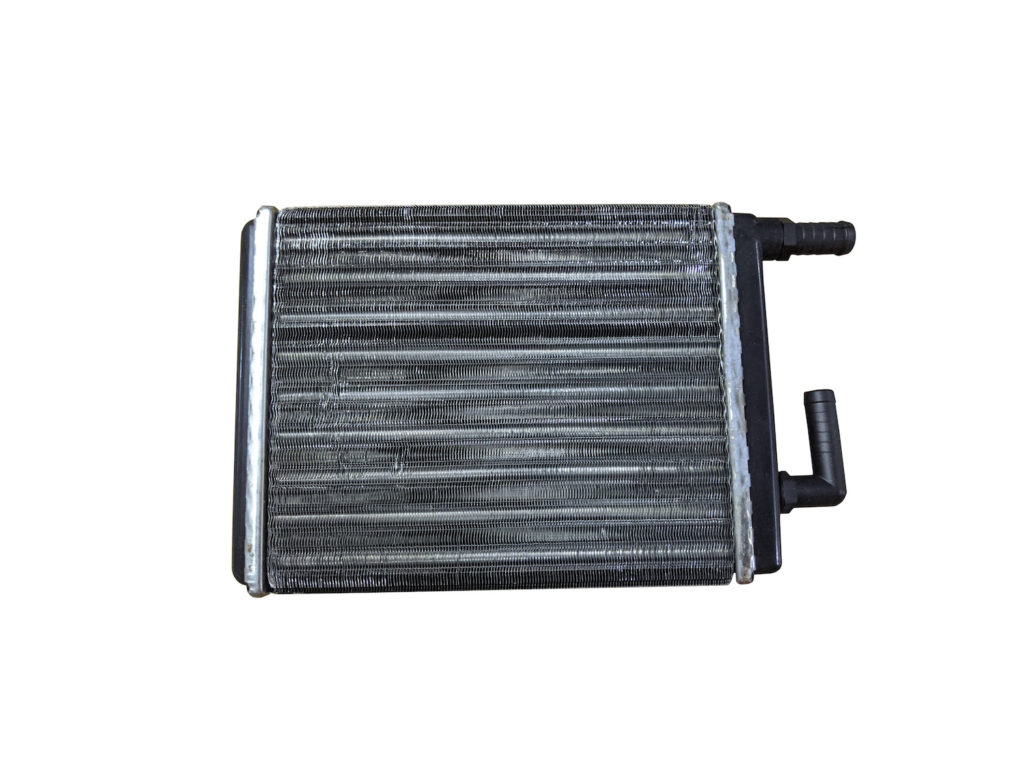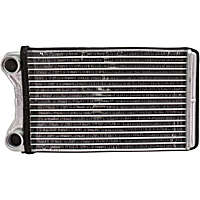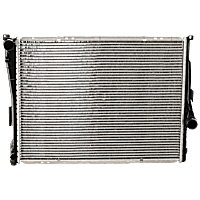Although the heater core is a simple device, it can cause serious problems when it fails. Replacement can also be very costly due to the part’s location, which is usually behind the dashboard.
How can you tell if your heater core is bad? First, you’ll want to familiarize yourself with the common symptoms of a heater core problem.

5 Signs of a Bad Heater Core
Like your car’s radiator, the heater core is a heat exchanger. But while the radiator transfers heat from the hot coolant into the atmosphere, the heater core transfers heat to the cabin.
You’ll also notice that the heater core, with its tanks and fins, looks just like a mini radiator.
The heater core has an inlet and an outlet pipe that connect to the car’s cooling system. Hot engine coolant enters the heater core through the inlet pipe. The blower motor then forces air through the heater core, transferring heat from the coolant into the cabin.

Note: It’s important to remember that the heater core is part of your car’s cooling system; it relies on hot engine coolant circulated by the water pump.
The heater core is designed to last the life of the vehicle—but that doesn’t always happen. Over time, the device can become clogged or develop leaks. When that happens, you’ll likely notice one or more of the following bad heater core symptoms:
Lack of Heat
As you might guess, a faulty heater core can cause your car’s heater to perform poorly. Anything that impedes coolant flow through the core (i.e., an external leak or internal obstruction) can prevent the core from keeping the cabin toasty.
In some cases, a heater core simply becomes fatigued over time and starts to leak. However, there are also instances where a lack of upkeep can lead to a heater core’s early demise.

Film or Fog on The Windshield
A leaking heater core can also cause the windshield to fog up, as coolant vapor travels through the defrost vents. Try to wipe the fog off of the windshield—if it smears and has a sweet smell, it’s coolant from a leaking heater core.
Coolant Accumulated on the Floorboard
As was mentioned, the heater core is usually located behind your car’s dashboard. If you notice coolant accumulating on the floor of your car, that’s almost a guarantee that the heater core is leaking.
Low Coolant Level
If the heater core leak is severe enough, you may notice a low coolant level when you remove the cooling system pressure cap.
Engine Overheating
A low coolant level (caused by a leaking heater core) can lead to overheating and possible engine damage. Even a clogged heater core has the potential to obstruct coolant flow enough to cause overheating.

What Causes a Bad Heater Core?
For instance, if the coolant is not changed at the interval suggested by the vehicle manufacturer, it will eventually break down and become corrosive. When that happens, the coolant begins to eat away at the various metal components—including the heater core—within the cooling system.
Old coolant can also lead to sediment build-up that can clog the heater core.
How to Test a Bad Heater Core
Because the heater core is usually tucked away behind the dashboard, testing it can be tricky. Still, there are a couple of methods you can use to check for heater core leaks and obstruction.
Before testing the heater core, however, you should make sure the rest of the cooling system is working properly. There are a variety of cooling system problems—ranging from a low coolant level to a faulty water pump—that can mimic a bad heater core.
Note: If the temperature gauge has a colder reading than normal, there’s a good chance the thermostat is stuck open, resulting in poor heater performance.
Once you’ve ruled out other cooling system problems, you can test the heater core using an infrared thermometer. If you don’t have access to such a tool, you can perform a less precise version of the test using just your hands.
Here’s how it’s done:
Note: The following information is for educational and entertainment purposes only. Consult your vehicle’s factory information for specific repair instructions and recommended safety procedures.
- Start the vehicle and get the engine up to normal operating temperature.
- Set the heater to the MAX heat position.
- Check the temperature of the heater core hoses: Both hoses should be too hot to hold. Typically, the inlet hose should be about 20 degrees warmer than the outlet hose.
- If the outlet heater hose is significantly cooler than the inlet hose, the heater core is probably clogged.
Note: If both heater hoses are cold, the heater control valve (if the vehicle is equipped) may be faulty. - In some cases, you may be able to flush the heater core to fix the problem. But if that doesn’t work, the heater core is likely faulty and should be replaced.
You can also use a cooling system pressure tester to check the heater core (and the rest of the cooling system) for leaks.

Here’s how it’s done:
- Make sure the engine is cold, then remove the cooling system pressure cap.
Warning: Never remove the cooling system pressure cap when the engine is hot. Severe injury may result. - Top off the cooling system with coolant if needed.
- Attach the pressure tester in place of the pressure cap.
- Operate the plunger to pump up the pressure tester to the vehicle manufacturer’s rated system pressure (typically around 14 psi).
Warning: Never pressurize the system beyond the vehicle manufacturer’s specification. If greater pressure is applied, various parts of the cooling system may suffer extensive damage. - If the heater core and the rest of the cooling system are free from leaks, the pressure should hold. On the other hand, if the pressure drops rapidly, there is a leak somewhere.
- While the system is pressurized, you may be able to spot a heater core leak by looking for coolant under the dash and on the floorboard.
Frequently Asked Questions
Can you drive with a bad heater core?
If you have a bad heater core, you should bring your car in for repairs right away. Driving with a faulty heater core can be risky, as it can lead to overheating and extensive engine damage. Even a clogged heater core can prevent proper coolant circulation, causing your engine to run hot.
But if you must continue driving for a short distance, keep an eye on the temperature gauge. If the gauge begins to climb, pull over immediately and have your vehicle towed to the nearest repair facility.
Can a bad heater core cause overheating?
Yes, a leaking heater core can cause a loss of coolant and subsequent engine overheating. Although not as common, it’s also possible for a heater core to become obstructed enough to restrict coolant flow and cause overheating.
Does a bad heater core affect air conditioning?
In most cases, the answer is no. The heater relies on hot engine coolant, whereas the air conditioning (A/C) system uses refrigerant. The heater and A/C are, for the most part, two separate systems.
You can learn more by checking out our article on the difference between your car’s heater and air conditioner.

What is the typical cost to replace a heater core?
If you choose to have a professional replace your heater core, expect to pay somewhere between $500 and $1,000 to get the job done.
Products Mentioned in this Guide
Any information provided on this Website is for informational purposes only and is not intended to replace consultation with a professional mechanic. The accuracy and timeliness of the information may change from the time of publication.


 Heater Core
Heater Core
 Radiator
Radiator




























Hi, my 2005 Chevy Blazer is having some heater issues. We have replaced the Thermostat and back flushed the cooling system. Sometimes the heat works, most times it blows cold. There is no rhyme or reason why most days it blows cold and some odd days will blow kinda warm. Any help would be most appreciated. I have moved the different vents and it really doesn’t seem to have a effect.
Hi,
It’s very possible that the heater core is obstructed. Check the temperature of both the heater core inlet and outlet hoses (with the engine at operating temperature and the heater on). If the outlet hose is significantly cooler than the inlet hose, the heater core is likely faulty. Be careful when you do this as the hoses may be hot. It’s a good idea to use an infrared thermometer.
-Mia, Chief Mechanic @ CarParts.com
I have an 03 jeep grand cherokee and can smell coolant when i turn on the heat. Not a strong smell but its still noticeable. My temp is fine, no leaks/puddles in the cabin and the heat works well. Could my issue be the thermostat housing? Fyi…my recirc. Door is broken so i get cold air on the passenger side floor…could that be where the small is coming from if its a leaking thermostat housing?
Hi Peggy,
If you’re smelling coolant inside the cabin, chances are, there’s a heater core leak behind the dash. The leak probably isn’t severe enough to be dripping down onto the floorboard yet.
Of course, you’ll want to have a professional perform an in-person diagnosis to know for certain.
I have a 2007 Jeep commander that’s been over heating and losing heat . I have replaced the water pump and thermostat. And it still does it . Burped it today and it was doing good , heat was working , not over heating . But after shutting it off to go into a store , left and it started over heating not long after leaving the store . And we did flush the heater core . Need help . Trying to get this fixed
Hi Jojo,
You might have an internal engine problem (e.g., blown head gasket). It can also be difficult to get all of the air out of modern cooling systems without a vacuum fill tool, so it’s possible there might still be air in the system.
I have a 2019 Ford Expedition Limited with retractable steps. I noticed fluid on my steps, on the front passenger side, when I opened the door and the step popped out. I thought maybe oil leak, but it looks orange so I’m thinking engine coolant. Could it be from the heater core?